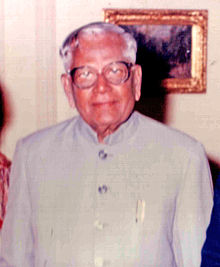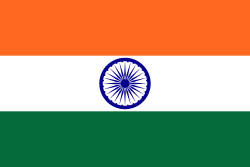Ramaswamy Venkataraman
| Hans Excellence Ramaswamy Venkataraman | |
|---|---|
Ramaswamy Venkataraman | |
| Indiens 8. præsident | |
| Embedsperiode 25. juli 1987 – 25. juli 1992 | |
| Premierminister | Rajiv Gandhi V. P. Singh Chandra Shekhar P. V. Narasimha Rao |
| Vicepræsident | Shankar Dayal Sharma |
| Foregående | Giani Zail Singh |
| Efterfulgt af | Shankar Dayal Sharma |
| Indiens 7. vicepræsident | |
| Embedsperiode 31. august 1984 – 24. juli 1987 | |
| Præsident | Giani Zail Singh |
| Foregående | Mohammad Hidayatullah |
| Efterfulgt af | Shankar Dayal Sharma |
| Personlige detaljer | |
| Født | 4. december 1910 Thanjavur, Tamil Nadu, Indien |
| Død | 27. januar 2009 (98 år) New Delhi, Delhi, Indien |
| Dødsårsag | Multiorgansvigt |
| Politisk parti | Indian National Congress |
| Ægtefælle | Janaki Venkataraman |
| Uddannelsessted | Madras Universitet Loyola College |
| Religion | Hinduisme |
| Underskrift |  |
| Informationen kan være hentet fra Wikidata. | |
Ramaswamy Venkataraman (4. december 1910 – 27. januar 2009) var en indisk jurist og politiker, der var Indiens præsident fra 1987 til 1992.[1]
Venkataraman var vicepræsident i Indien i perioden 1984-87. I juli 1987 blev han indsat som Indiens 8. præsident efter Giani Zail Singh. Venkataramans præsidentembede ophørte den 25. juli 1992, hvor han blev efterfulgt af Shankar Dayal Sharma.
Referencer
- ^ "Former Presidents". The President of India. Hentet 15. oktober 2019.
Eksterne henvisninger
| ||||||
| ||||||||
| Spire |
|
Medier brugt på denne side
The National Emblem of India is derived from the time of the Emperor Ashoka. The emblem is a replica of the Lion of Sarnath, near Varanasi in Uttar Pradesh. The Lion Capital was erected in the third century BC by Emperor Ashoka to mark the spot where Buddha first proclaimed his gospel of peace and emancipation to the four quarters of the universe. The national emblem is thus symbolic of contemporary India’s reaffirmation of its ancient commitment to world peace and goodwill. The four lions(one hidden from view ) – symbolising power, courage and confidence- rest on a circular abacus. The abacus is girded by four smaller animals—Guardians of the four directions: The Lion of the North, The Horse of the West, The Bull of the South and The Elephant of the East. The abacus rests on a lotus in full bloom, exemplifying the fountainhead of life and creative inspiration. The motto 'Satyameva Jayate' inscribed below the emblem in Devanagari script means 'truth alone triumphs'.
Forfatter/Opretter: The360degree, Licens: CC BY-SA 4.0
Icon for stubs about Indian political personality
Forfatter/Opretter: Ramaswamy Venkataraman, digitalization by Hindustanilanguage, Licens: CC BY-SA 3.0
Ramaswamy Venkataraman's Autograph




